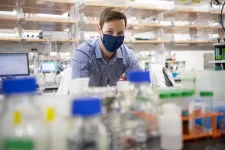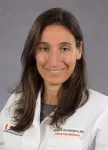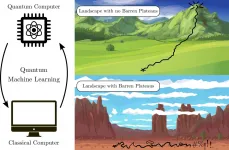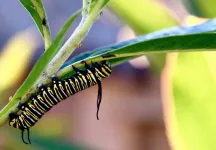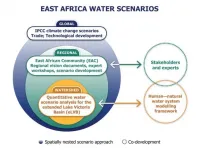INFORMATION:
The research team spans across the Ohio State campus in the departments of biomedical engineering, neurosurgery, biology, nutrition, neuroscience, neurology and surgery; along with the biomedical science graduate program. The team also includes scientists at the Georgia Institute of Technology in Atlanta, National University of Colombia in Bogota, Columbia and Indiana University School of Medicine in Indianapolis.
This study is funded by grants from the National Institute of Neurological Disorders and Stroke and the National Institute of Biomedical Imaging and Bioengineering.
New technology 'retrains' cells to repair damaged brain tissue in mice after stroke
Scientists at The Ohio State University Wexner Medical Center, College of Engineering and College of Medicine have developed technology to "retrain" cells to help repair damaged brain tissue.
2021-03-19
(Press-News.org) COLUMBUS, Ohio - Most stroke victims don't receive treatment fast enough to prevent brain damage. Scientists at The Ohio State University Wexner Medical Center, College of Engineering and College of Medicine have developed technology to "retrain" cells to help repair damaged brain tissue. It's an advancement that may someday help patients regain speech, cognition and motor function, even when administered days after an ischemic stroke.
Engineering and medical researchers use a process created by Ohio State called tissue nanotransfection (TNT) to introduce genetic material into cells. This allows them to reprogram skin cells to become something different - in this case vascular cells - to help fix damaged brain tissue.
Study findings published online today in the journal Science Advances.
In this mouse study, cells were 'pre-conditioned' with specific genes and injected into the stroke-affected brains, where they promoted the formation of new blood vessels via reprogramming and the repair of damaged brain tissue.
"We can rewrite the genetic code of skin cells so that they can become blood vessel cells," said Daniel Gallego-Perez, an assistant professor of biomedical engineering and surgery at Ohio State who is leading the research. "When they're deployed into the brain, they're able to grow new, healthy vascular tissue to restore normal blood supply and aid in the repair of damaged brain tissue."
Researchers studied the process in mice and found that those treated with this innovative cell therapy regained 90% of their motor function. MRI scans showed damaged areas of the brain were repaired within a few weeks.
"We found that the mice have a higher recovery because the cells that are being injected into the affected area also release healing signals in the form of vesicles that help in the recovery of damaged brain tissue" said Natalia Higuita Castro, assistant professor of biomedical engineering and surgery at Ohio State and a co-lead author on the study.
Every 40 seconds, someone in the United States suffers a stroke. It's the second-leading cause of death worldwide, and those who survive often have irreversible brain damage resulting in paralysis, speech impairment and loss of motor function. No treatments exist to address the lasting and debilitating damage to brain tissue caused by stroke.
Although medical advancements have allowed doctors to clear clots in the brain faster and improve outcomes, this is only effective if done within a few hours of the stroke, before the brain tissue dies. About 80% of ischemic stroke patients don't receive the clot-busting therapy in time to prevent permanent deficits to their speech, cognition and motor function.
"The thought was that once brain tissue dies, that was it," said Dr. Shahid Nimjee, a neurosurgeon at Ohio State Wexner Medical Center, a member of Ohio State's Neurological Institute and co-author of the study. "We're now learning that there could be opportunities to regenerate cells to restore brain function."
Researchers continue to study this approach, and they're also exploring other potential uses for this technology to treat brain disorders such as Alzheimer's and autoimmune diseases.
ELSE PRESS RELEASES FROM THIS DATE:
Building tough 3D nanomaterials with DNA
2021-03-19
New York, NY--March 19, 2020--Columbia Engineering researchers, working with Brookhaven National Laboratory, report today that they have built designed nanoparticle-based 3D materials that can withstand a vacuum, high temperatures, high pressure, and high radiation. This new fabrication process results in robust and fully engineered nanoscale frameworks that not only can accommodate a variety of functional nanoparticle types but also can be quickly processed with conventional nanofabrication methods.
"These self-assembled nanoparticles-based materials are so resilient that they could fly in space," says Oleg Gang, professor ...
Researchers identify immune cells that contribute to transplant rejection
2021-03-19
PITTSBURGH, March 19, 2021 - Non-circulating memory T cells, whose main function is to provide local protection against re-infection, contribute to chronic transplant rejection, University of Pittsburgh School of Medicine researchers reveal in a paper published today in Science Immunology.
The scientists show that these "tissue-resident memory T cells" are harmful in situations where antigens that the cells recognize are present in the body for a long time, such as in cases of an organ or tissue transplant. This finding is an important step toward improving therapies to help prevent organ rejection in transplant recipients.
"Tissue-resident memory T cells serve an important surveillance function," said co-senior author Martin Oberbarnscheidt, ...
Vaccination by inhalation
2021-03-19
CAMBRIDGE, MA -- Many viruses infect their hosts through mucosal surfaces such as the lining of the respiratory tract. MIT researchers have now developed a vaccination strategy that can create an army of T cells that are ready and waiting at those surfaces, offering a quicker response to viral invaders.
The researchers showed that they could induce a strong memory T cell response in the lungs of mice by giving them a vaccine modified to bind to a protein naturally present in mucus. This can help ferry the vaccine across mucosal barriers, such as the lining of the lungs.
"In this paper, we specifically focused on T cell responses that would be useful against viruses or cancer, and our idea was to use this protein, albumin, as sort of a Trojan horse to ...
Better batteries start with basics -- and a big computer
2021-03-19
To understand the fundamental properties of an industrial solvent, chemists with the University of Cincinnati turned to a supercomputer.
UC chemistry professor and department head Thomas Beck and UC graduate student Andrew Eisenhart ran quantum simulations to understand glycerol carbonate, a compound used in biodiesel and as a common solvent.
They found that the simulation provided detail about hydrogen bonding in determining the structural and dynamic properties of the liquid that was missing from classical models. The study was published in the Journal of Physical Chemistry B.
Glycerol carbonate could be a more environmentally ...
Importance of crisis standards of care for equitable allocation of scarce medical re
2021-03-19
During a public health crisis like the COVID-19 pandemic, U.S. hospitals need to allocate scarce medical resources in an equitable manner, according to clinicians and ethicists at the University of Miami Miller School of Medicine.
"Significant concerns have been raised that crisis standards of care may be biased against certain patients based on race or ethnicity," said Hayley Gershengorn, M.D., associate professor of pulmonary and critical care medicine. "To examine that issue, we analyzed over a thousand medical records from two academic hospitals where University of Miami faculty see patients and found no disparities ...
COVID-19 transmission rare in schools with masking, distancing, contact tracing
2021-03-19
In-school COVID-19 transmission is rare - even among close school contacts of those who test positive for the virus - when schools heed public health precautions such as mandatory masking, social distancing and frequent hand-washing, according to results of a pilot study in Missouri aimed at identifying ways to keep elementary and secondary schools open and safe during the pandemic. A close contact is anyone who has been within 6 feet for more than 15 minutes in a 24-hour period with someone infected with COVID-19.
The study is part of a larger, ongoing collaboration involving the Centers for Disease Control and Prevention (CDC), Washington University School of Medicine in St. Louis, ...
Solving 'barren plateaus' is the key to quantum machine learning
2021-03-19
LOS ALAMOS, N.M., March 19, 2021--Many machine learning algorithms on quantum computers suffer from the dreaded "barren plateau" of unsolvability, where they run into dead ends on optimization problems. This challenge had been relatively unstudied--until now. Rigorous theoretical work has established theorems that guarantee whether a given machine learning algorithm will work as it scales up on larger computers.
"The work solves a key problem of useability for quantum machine learning. We rigorously proved the conditions under which certain architectures of variational quantum algorithms will or will not have barren plateaus as they are scaled up," said Marco Cerezo, lead author on the paper published in Nature Communications ...
Tropical species are moving northward in U.S. as winters warm
2021-03-19
Notwithstanding last month's cold snap in Texas and Louisiana, climate change is leading to warmer winter weather throughout the southern U.S., creating a golden opportunity for many tropical plants and animals to move north, according to a new study appearing this week in the journal Global Change Biology.
Some of these species may be welcomed, such as sea turtles and the Florida manatee, which are expanding their ranges northward along the Atlantic Coast. Others, like the invasive Burmese python -- in the Florida Everglades, the largest measured 18 feet, end-to-end --maybe less so.
Equally unwelcome, and among the quickest to spread into warming areas, are ...
Emphasizing urgency alone won't increase support for major climate policies, study finds
2021-03-19
In light of recent extreme climate events--from wildfires blazing through the western US to snowstorms sweeping Texas into a blackout--climate scientists and media outlets have repeatedly called out the urgency of tackling the climate crisis. But in a new study published March 19 in the journal One Earth, researchers found that emphasizing urgency alone is not enough to kindle public support for climate change policies.
"We had the impression that policymakers shy away from enacting ambitious, stringent climate policy because they're afraid of ...
Strengthening water resources planning in East Africa
2021-03-19
IIASA researchers worked with local stakeholders from the East African Community to explore and co-develop regional water scenarios that can enhance understanding of the up- and downstream water sector interactions in the extended Lake Victoria Basin to facilitate rational water resource planning.
East Africa is the world's fastest growing region outside of Asia, with an estimated growth of 5% and above over the last decade. Part of this success can likely be attributed to the East Africa Vision 2050, which was launched in 2015 by the Heads of States of the East African Community (EAC) - an intergovernmental organization composed of six countries in the African Great Lakes ...
LAST 30 PRESS RELEASES:
Short-circuiting pancreatic cancer
Groundbreaking mapping: how many ghost particles all the Milky Way’s stars send towards Earth
JBNU researchers propose hierarchical porous copper nanosheet-based triboelectric nanogenerators
A high-protein diet can defeat cholera infection
A more accurate way of calculating the value of a healthy year of life
What causes some people’s gut microbes to produce high alcohol levels?
Global study reveals widespread burning of plastic for heating and cooking
MIT study shows pills that communicate from the stomach could improve medication adherence
Searching for the centromere: diversity in pathways key for cell division
Behind nature’s blueprints
Researchers search for why some people’s gut microbes produce high alcohol levels
Researchers find promising new way to boost the immune response to cancer
Coffee as a staining agent substitute in electron microscopy
Revealing the diversity of olfactory receptors in hagfish and its implications for early vertebrate evolution
Development of an ultrasonic sensor capable of cuffless, non-invasive blood pressure measurement
Longer treatment with medications for opioid use disorder is associated with greater probability of survival
Strategy over morality can help conservation campaigns reduce ivory demand, research shows
Rising temperatures reshape microbial carbon cycling during animal carcass decomposition in water
Achieving ultra-low-power explosive jumps via locust bio-hybrid muscle actuators
Plant-derived phenolic acids revive the power of tetracycline against drug-resistant bacteria
Cooperation: A costly affair in bacterial social behaviour?
Viruses in wastewater: Silent drivers of pollution removal and antibiotic resistance
Sub-iethal water disinfection may accelerate the spread of antibiotic resistance
Three in four new Australian moms struggle with body image
Post-stroke injection protects the brain in preclinical study
Cardiovascular risk score predicts multiple eye diseases
Health: estimated one in ten British adults used or interested in GLP-1 medications for weight loss
Exercise to treat depression yields similar results to therapy
Whooping cough vaccination for pregnant women strengthens babies’ immune system
Dramatic decline in new cases of orphanhood in Uganda driven by HIV treatment and prevention programs
[Press-News.org] New technology 'retrains' cells to repair damaged brain tissue in mice after strokeScientists at The Ohio State University Wexner Medical Center, College of Engineering and College of Medicine have developed technology to "retrain" cells to help repair damaged brain tissue.

